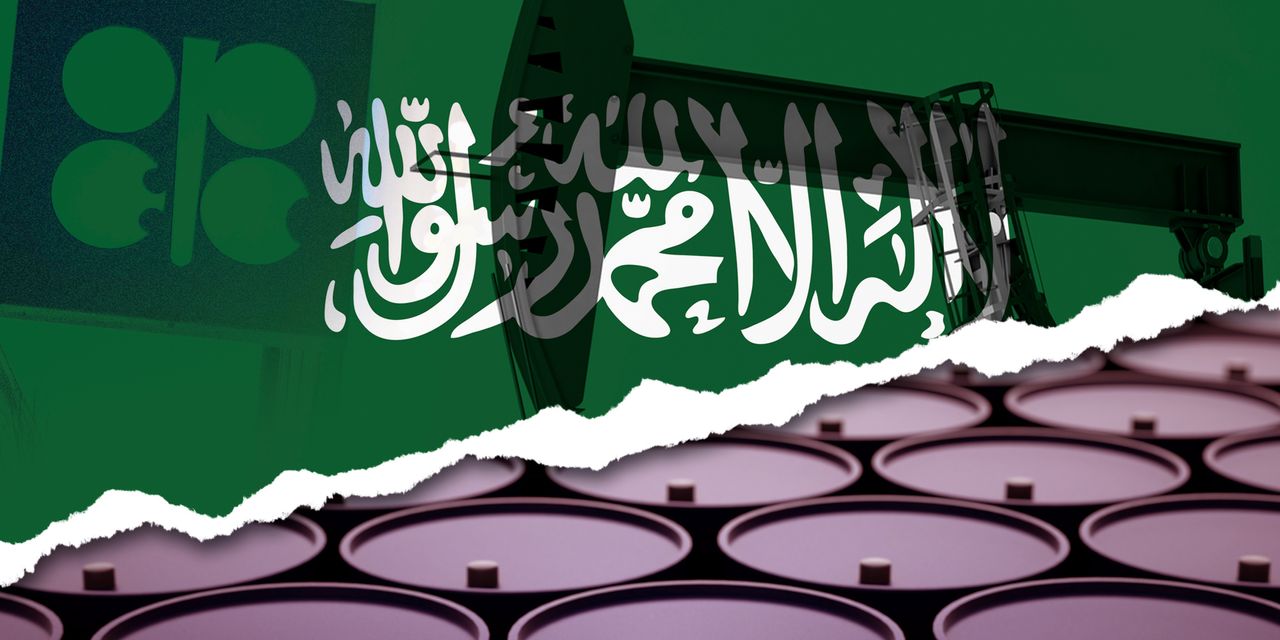Saudi Arabia’s decision a month ago to extend its crude-production cut to the end of the year hasn’t yet lifted oil prices past the psychologically important $100-a-barrel level, but it did contribute to the largest quarterly price percentage gain in over a year.
“The OPEC+ plan has been working,” said Jim Burkhard, vice president and head of research for oil markets, energy and mobility, at S&P Global Commodity Insights, in market analysis issued Tuesday. Production cuts by Saudi Arabia and Russia have had the “intended effect of tightening the global oil balance and have convinced previously bearish speculators to turn bullish.”
Saudi Arabia announced on Sept. 5 that it would extend its voluntary output cut through December. Separately, Russia’s Deputy Prime Minister Alexander Novak said his country would extend its additional voluntary cut in oil supplies to world markets by 300,000 barrels a day, also to the end of the year.
The front-month contract for U.S. benchmark West Texas Intermediate crude
CL.1,
settled at $93.68 a barrel on the New York Mercantile Exchange on Sept. 27, the highest since Aug. 29, 2022. On Tuesday, the front-month November WTI contract
CLX23,
settled at $89.23, up 41 cents, or 0.5%.
Global benchmark Brent crude on ICE futures Europe saw its December contract
BRNZ23,
BRN00,
ended Tuesday at $90.92, up 21 cents, or 0.2%. Front-month prices settled at $96.55 on Sept. 27, the highest since Nov. 7.
For the third quarter, WTI oil posted a rise of nearly 29%, while Brent was up by more than 27%, with both benchmarks scoring their highest quarterly percentage gains since the first quarter of 2022.
Oil futures rose more than 13% from trough to peak after Saudi Arabia and Russia “caught markets off gauge with their early announcement of an extension to voluntary output cuts through year-end,” said Tyler Richey, co-editor of Sevens Report Research. “That development sparked the bullish combination of speculative short-covering and physical traders chasing the rally.”
In late September, however, the oil market became “overbought,” with WTI futures “pressed into some technical resistance” and reaching some measured move targets on the harts in the mid-$90-a-barrel range,” he said.
Over the course of the last week, there has been a “healthy bout of profit-taking,” said Richey, as markets digest a “shifting fundamental backdrop characterized by fixed-income market pricing in a ‘higher for longer’ [interest] rate outlook and a more likely soft landing economic scenario.”
Read: Why gasoline prices are set to fall even as oil marches toward $100 a barrel
OPEC+ “costs” and challenges
The recent jump in oil prices over $90 a barrel has “not come without costs” for OPEC+, said Burkhard. The group of oil producers includes members of the Organization of the Petroleum Exporting Countries and their allies such as Russia.
A year ago, Saudi Arabia was producing 11 million barrels a day, but it is now producing 9 million barrels a day, he said. However, since June, oil prices are up about $20 a barrel in terms of monthly average prices, he said.
For OPEC+, their work is “not over,” said Burkhard. “OPEC+ leaders need to remain committed to supply restraint — and keep output near current levels over the next year — to keep oil inventories generally low and prices high.”
Burkhard said OPEC+ supply restraint is a “necessary condition, but not unilaterally sufficient,” so there may be times when more cuts are needed if the goal is to support prices above $80.
The challenges OPEC+ faces in terms of supporting the oil market is shaped by two variables: world oil demand growth and the change in oil production outside of OPEC+, he said.
Conditions are “most suitable” for OPEC+ when demand growth is stronger than supply growth outside of OPEC+, Burkhard said, with that situation clearly demonstrated in 2021.
This year, however, the picture changed as production gains outside of OPEC+ exceeded demand growth, so OPEC+ had to cut production to prevent rising oil inventories and reverse a 12-month oil-price decline from June 2022 to June 2023, he explained.
He said the global supply deficit will shrink each month from September to December so the highest oil prices for this year are likely in September or October.
Committee meeting
On Wednesday, OPEC+ will hold a meeting of the Joint Ministerial Monitoring Committee and traders will look to that meeting for potential signs of the next move for major oil producers.
The gathering is held every two months and though the committee doesn’t have the power to make changes to production levels, it has the authority to call for a full OPEC+ meeting, if needed. The next regular OPEC+ meeting is scheduled for Nov. 26.
“A lot of the heavy lifting for setting the 2024 production levels was done at the June meeting, and any tweaking that is deemed necessary will likely take place at the November full ministerial meeting,” said Helima Croft, head of global commodity strategy at RBC Capital Markets, in a note dated Monday. RBC doesn’t anticipate “any major shift in production policy” at the meeting.
She said that in conversations with Saudi Energy Minister Prince Abdulaziz bin Salman in Calgary two weeks ago, the energy minister reiterated that the “jury is still out,” citing Chinese demand, European manufacturing data, and global central bank action as key criteria that will be considered in Riyadh’s review process.
“While we continue to contend that one should always be prepared for a Saudi surprise, we are not anticipating that the Kingdom will declare ‘mission accomplished’ at this juncture, especially given the continuing uncertainty about the broader macro outlook and central bank action,” she wrote.
Next move?
So far, some analysts would refer to actions by Saudi Arabia as a success.
The Saudis have shown “strong leadership and discipline” as the de facto leader of OPEC+ since COVID initially roiled global energy markets, Sevens Report’s Richey told MarketWatch.
With its voluntary cuts, Saudi Arabia is leaving around 1.5 million barrels a day or more in the ground right now, relative to their recent production capacity peak, he said.
However, it is “much better off financially” selling 10 million barrels a day with futures near $90 a barrel, for example, than it would be selling 11.5 million barrels a day with prices at $60 a barrel, said Richey.
Unless we see a meaningful move beyond $100 a barrel and steady demand expectations, the Saudis are “not likely to ramp up production meaningfully and risk a reversal in the currently strong oil market,” he said.
Read the full article here









Leave a Reply